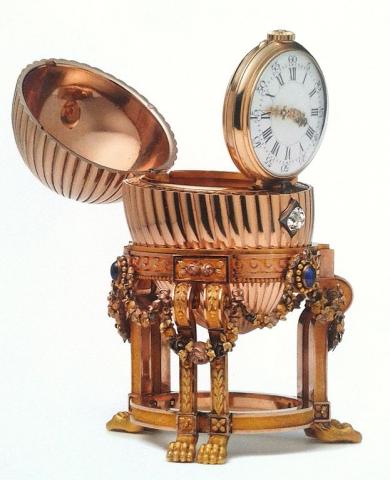The story behind this Imperial Easter Egg, featuring a Vacheron & Constantin watch, is nearly impossible to believe.
Among other improbable events, the egg—third in a series of 50 which the House of Faberge created for the Russian Imperial Family—survived a close encounter with the melting pot. An American buyer—who purchased the artifact at a flea market for $14,000—had only one purpose in mind: Sell the object—whatever it was—for the gold it contained.
Trying to find a buyer, so he could make a quick thousand dollars, the new owner came up short. No one would pay $15,000 for the item.
It was a good thing—for the still-unidentified owner and the entire art-loving world—that no buyer of gold believed the item was worth that sum of money. When he learned the true value of his possession—around $30 million—the owner literally fell on the floor in dumbfounded amazement.
So what is the story behind this egg?
Tsar Alexander III purchased it as an Easter gift for his wife which he gave to her in the spring of 1887. It was the first of the Imperial Easter eggs over which the House of Faberge had total creative control. The only requirement, which Peter Carl Faberge and his team had to honor, was to be sure this egg—and all future eggs—contained surprises.
Finished in 1887, this jeweled Egg is ridged with yellow gold. It has a tripod pedestal, on which it stands, featuring chased lion paw feet. The stand is encircled with colored gold garlands which are suspended from cabochon blue sapphires. The stand also includes rose diamond set bows.
As for the egg, it has a beautiful diamond which serves to open it. Inside—as the surprise—is the Vacheron & Constantin watch.
 No one can be sure how the third egg made its way to America. When the Bolshevik Revolution occurred in Russia, during 1917, Peter Carl Faberge lost his job as the Crown jeweler. Not only did he lose his job, he lost his company and the rights to his company’s name.
No one can be sure how the third egg made its way to America. When the Bolshevik Revolution occurred in Russia, during 1917, Peter Carl Faberge lost his job as the Crown jeweler. Not only did he lose his job, he lost his company and the rights to his company’s name.
He fled for his life to Switzerland, traveling in the back of a horse-drawn carriage. His entire professional world was upended by the Bolsheviks who not only confiscated Faberge’s items, they took Faberge’s completed works from their rightful owners, melting down what they hadn’t broken-up and sold.
Around 2011, a Faberge enthusiast in America discovered an auction catalog from the 1960s. It included a picture of what looked like the missing Third Imperial Fabergé Easter Egg. Could it be the lost egg?
Journalists began writing articles about the Third Imperial Egg, but no one came forward. It wasn’t until 2014, when the unwitting owner did an online Google search—for “egg+Vacheron & Constantin”—that he stumbled upon one of those 2011 articles.
Boarding a plane to London, pictures in hand, he was able to meet with an expert—Kieran McCarthy—who couldn’t believe what he saw. The pictures seemed to depict the “missing” Third Imperial Faberge Easter Egg.
Flying to the States with the owner—who lived in an unnamed town, in America’s Midwest, in a home overlooking a Dunkin’ Donuts shop—McCarthy laid eyes on the Third Imperial Egg. It was sitting on a kitchen counter top, next to some muffins, as though it were just part of the breakfast dishes.

Verifying the object’s true identity, McCarthy then told the owner how much it was worth. One can only imagine how relieved he was that no gold-buyer wanted to melt down his life-changing, flea-market purchase. Even PBS “Road Show” revelations aren’t that stupendous!
It took very little time for the Third Imperial Egg to have a new owner (who is also anonymous). The purchase price, facilitated by a London dealer, was reportedly $33 million.
Fortunately, the new owner has allowed the Third Imperial Egg to be viewed by the public. It does bear a few markings which it didn’t have when Russia’s royal family owned it, however.
They are the scratch marks, made by would-be buyers of gold, who were trying to determine whether the little egg was worth considering. Turns out, they all turned-down the most astonishing purchase they could have ever made.
Media Credits
Image depicting the Third Imperial Fabergé Egg, created by the House of Fabergé and given by Tsar Alexander III to his wife as an Easter gift during the spring of 1887.
In-text description: "Third imperial Fabergé egg.svg from Wikimedia Commons by K. D. Schroeder, CC-BY-SA 4.0



